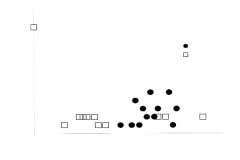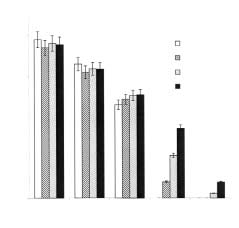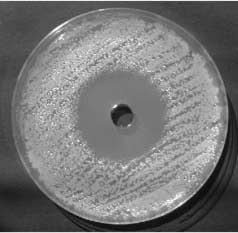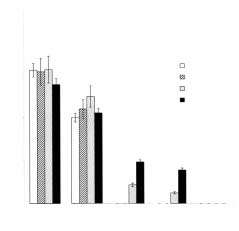Pp 0504 bjbs61(2)
Allicin and methicillin-resistant Staphylococcus aureus
Antibacterial activity of a new, stable, aqueousextract of allicin against methicillin-resistant
Staphylococcus aureus
R R. CUTLER* and P. WILSON†
*University of East London, School of Health and Bioscience, Stratford Campus,Romford Road, London E15 4LZ; and Department of Medical Microbiology,
The increasing prevalence of methicillin-resistant
St Bartholomew's Hospital, West Smithfield, London EC1A 7BE, UK
Staphylococcus aureus (MRSA) in hospitals and thecommunity has led to a demand for new agents that couldbe used to decrease the spread of these bacteria. Topical
Accepted: 19 March 2004
agents such as mupirocin have been used to reduce nasalcarriage and spread and to treat skin infections; however,resistance to mupirocin in MRSAs is increasing. Allicin is
the main antibacterial agent isolated from garlic, butnatural extracts can be unstable. In this study, a new, stable,
Control of the spread of antibiotic-resistant bacteria and the
aqueous extract of allicin (extracted from garlic) is tested on
treatment of infections caused by them is a major problem
30 clinical isolates of MRSA that show a range of
worldwide. In particular, methicillin-resistant
Staphylococcus
susceptibilities to mupirocin. Strains were tested using agar
aureus (MRSA) presents major infection control problems for
diffusion tests, minimum inhibitory concentration (MIC)
patients and hospital staff, as its incidence in Europe has
and minimum bactericidal concentration (MBC). Diffusion
risen from 3% in 1992 to 37% in 1999.1–4
tests showed that allicin liquids produced zone diameters
Topical agents are important in controlling the carriage
>33 mm when the proposed therapeutic concentration of
and spread of MRSA. Mupirocin (pseudomonic acid), a
500 µg/mL (0.0005% w/v) was used. The selection of this
fermentation product produced by
Pseudomonas fluorescens
concentration was based on evidence from the MIC, MBC
(NCIB 10586), is a standard product used to deal with MRSA
and agar diffusion tests in this study. Of the strains tested,
carriage and to prevent its spread. It has also proved to be an
88% had MICs for allicin liquids of 16 µg/mL, and all strains
effective treatment for skin infections and plays a crucial role
were inhibited at 32 µg/mL. Furthermore, 88% of clinical
in the control of MRSA outbreaks.
isolates had MBCs of 128 µg/mL, and all were killed at 256
However, resistant strains were described soon after its
µg/mL. Of these strains, 82% showed intermediate or full
introduction. Moreover, the increased use of mupirocin,
resistance to mupirocin; however, this study showed that a
especially for chronic infections, has led to an increased
concentration of 500 µg/mL in an aqueous cream base was
incidence of resistance. In a recent survey from Spain, levels
required to produce an activity equivalent to 256 µg/mL
of mupirocin resistance in clinical isolates was reported to
have increased from 7.7% in 1998 to 19% in 2000, and somehospitals have reported incidences as high as 63%.2
The continuing spread of MRSA and the increase in
Drug resistance, microbial.
mupirocin-resistant strains5 highlight the need for
alternative topical agents
Methicillin resistance.
Garlic and its extracts have been used to treat infections
Staphylococcus aureus.
for thousands of years.6 Allicin (the name being derived from
Sulfinic acids.
that of the garlic species
Allium sativum) is considered to bethe main biologically active antimicrobial phytochemicalproduced in garlic extracts, and was first recognised as such
Pure allicin (allyl 2-propenethiosulphinate)6 is said to be
highly volatile, poorly miscible with water and has the
Allicin is an oxygenated sulphur compound, formed when
odour of freshly crushed garlic.9 In order to produce a stable
garlic cloves are crushed. Alliin is the stable precursor of
agent that can be used in topical formulations, an aqueous
allicin and is stored in compartments in the plant that
allicin extract is needed.
separate it from the enzyme alliinase (also called alliin lyase).
In this study, a purified aqueous extract of allicin, isolated
When crushed, they mix and alliin is converted rapidly to
from a natural source by a patented cold aqueous extraction
allicin by the action of this enzyme. The antibacterial activity
method (Allicin International, Half House, Military Road,
of allicin was reviewed by Ankri and Mirelman in 1999.8
Rye, East Sussex, UK) is used. This extract is tested againstmupirocin-resistant and mupirocin-susceptible strains of
Correspondence to: Dr Ron Cutler
MRSA. Two formulations, liquid allicin and liquid allicin
mixed in a cream formulation, are tested.
BRITISH JOURNAL OF BIOMEDICAL SCIENCE 2004
61 (2)
BRITISH JOURNAL OF BIOMEDICAL SCIENCE 2004
61 (2)


Allicin and methicillin-resistant Staphylococcus aureus
Number of strains
Fig. 1. Number of strains and the size of zones of inhibition withallicin (500 µg/mL) and mupirocin against Staphylococcus aureus.
Materials and methods
Concentration of allicin (ug/ml)
Bacterial strains
Fig. 2. Average diameter of zones of inhibition for allicin liquid
Thirty clinical isolates and one control strain (Oxford Strain,
against Staphylococcus aureus strains that showed resistance,
NCTC 6571) of S. aureus were tested. All 30 clinical isolates
intermediate resistance or sensitivity to mupirocin.
were obtained from the Royal London and St. Bartholomew'sHospitals and had been identified as showing multipleantibiotic resistance. All strains were resistant to methicillin
The bacterial inoculum used was approximately Log 6
and had no apparent epidemiological connection
colony-forming units (cfu)/mL. Cultures were incubatedovernight at 37˚C and examined for growth the following
day. Subcultures of these were used to determine MBC.12
A 5000 µg/mL solution of allicin in water was provided byAllicin International. As it was an extracted product, thepurity of the allicin solution was tested and the
concentration confirmed by Allicin International using thehigh-performance liquid chromatography (HPLC) method
of Lawson, Wang and Hughes.10
The control strain produced a 35-mm diameter zone ofinhibition to mupirocin. Of the clinical isolates, five strains
were identified as fully susceptible (zone sizes 33–45 mm), 12
The allicin liquid and allicin made up in aqueous cream were
showed intermediate susceptibility (zone sizes 12–23 mm)
tested for antimicrobial activity against MRSA using an agar
and 13 strains were resistant (no zone of inhibition).
well diffusion method. Muller-Hinton agar plates were
Variability of zone size was considerable, ranging from 0–45
inoculated using the methods recommended by the British
mm. The most frequent result (13 strains) showed no zone of
Society for Antimicrobial Chemotherapy (BSAC).11
inhibition. The second most common group (11 strains)
Circular wells (6 mm) were cut in the agar culture media
produced intermediate zone sizes (8–19 mm). Two strains
and filled with 100 µL cream or liquid. The accuracy of the
were highly susceptible, producing zone sizes of 45 mm.
method used to deliver these volumes was confirmed by
weighing the agar plates before and after the fluid andcream were added.
Allicin liquid activity
Mupirocin activity against the same MRSA strains was
Allicin liquid was active against S. aureus strains down to 62.5
determined using a 5 µg paper disk (Oxoid, UK) on Muller-
µg/mL (equal to 6.25 µg of allicin in 100 µL [the volume
Hinton agar plates
added to each well]). No activity was detected below 62.5
µg/mL, and concentrations of 250 µg/mL and above were the
Minimum inhibitory and bactericidal concentrations of allicin
most active.
The average zone sizes produced against these strains
Standard methods based on those of Lorian12 were used to
were 25 mm at 250 µg/mL, 32 mm at 500 µg/mL and 38 mm
determine minimum inhibitory concentration (MIC) and
at 1000 µg/mL. The spread of zone size to allicin was smaller
minimum bactericidal concentration (MBC). Strains were
than that found with mupirocin (Fig. 1). Zone sizes ranged
cultured overnight at 37˚C in Muller-Hinton broth (Oxoid,
from 23–38 mm at 500 µg/mL, and from 31–44 mm at 1000
CM 405). Concentrations of allicin between 1–1000 µg/mL
µg/mL (Figs. 2 and 3).
and broth containing no antimicrobial agent (negativecontrol) were assessed. Creams were not tested by this
Allicin cream activity
method because the opacity they produced in the liquid
The control strain produced a 20 (±1.5) mm zone of inhibition
made determination of MIC impossible.
compared to 23 (± 1.5) mm for mupirocin-susceptible MRSAs
BRITISH JOURNAL OF BIOMEDICAL SCIENCE 2004 61 (2)
BRITISH JOURNAL OF BIOMEDICAL SCIENCE 2004 61 (2)


Allicin and methicillin-resistant Staphylococcus aureus
Concentration of allicin (ug/ml)
Fig. 3. A typical zone of inhibition produced by 500 µg/mL allicin
Fig. 4. Average diameter of zones of inhibition for allicin cream
against MRSA.
against Staphylococcus aureus strains that showed resistance,intermediate resistance or sensitivity to mupirocin.
and 21 (±1.5) mm for mupirocin-resistant MRSAs. When
Table 1. Susceptibility of MRSA clinical isolates to a stabilised allicin
prepared in Boots' aqueous cream, allicin was found to be
extract, shown as the percentage of strains with different minimal
highly active against all strains at a concentration of 500
inhibitory concentrations (MIC) and minimum bactericidal
µg/mL. No activity was detected below 125µg/mL (Fig. 4).
Comparison of allicin activity in cream and liquidThe average zone size for 250 µg/mL allicin liquid was 25 (±1)
mm. This was almost identical to the average zone size of 23.8
(±2) mm obtained with 500 µg/mL allicin in aqueous cream.
Minimum inhibitory and bactericidal concentrations
The control strain tested (Oxford S. aureus) gave an MIC of32 µg/mL and an MBC of 256 µg/mL. The MICs for theclinical isolates tested were either 16 or 32 µg/mL, the MBCs
Allicin is considered to be the most potent antibacterial
were either 128 or 256 µg/mL. The majority of the clinical
agent in crushed garlic extracts, but it can be unstable,
isolates had MICs of 16 µg/mL and MBCs of 128 µg/mL
breaking down within 16 h at 23˚C.6 However, the use of a
water-based extract of allicin stabilises the allicin molecule.
Of the clinical isolates, 88% had MICs of 16 µg/mL and
This may be due to two factors: the hydrogen bonding of
MBCs of 128 µg/mL, 18% were susceptible to mupirocin (as
water to the reactive oxygen atom in allicin can reduce its
indicated by the disk diffusion test), 47% showed
instability; and/or there may be water-soluble components in
intermediate susceptibility and 35% were resistant. All
crushed garlic that destabilise the molecule.14
mupirocin-resistant strains had MICs of 16 µg/mL, 23% had
The disadvantage to this approach is that allicin can react
MBCs of 128 µg/mL and 12% had MBCs of 256 µg/mL.
with water to form diallyl disulphide,15,16 which does notexhibit the same level of antibacterial activity as does allicin.
In 1991, Hughes and Lawson17 reported tests on a single
strain of S. aureus and noted that pure allicin had an MIC of27 µg/mL compared with 900 µg/mL for diallyl disulphide.
In a review of the subject, Schmitz and Jones13 considered
In the present study, 88% of strains had MICs for allicin of
the choices available in the battle against MRSA and
16 µg/mL, and all strains were inhibited by allicin at 32
concluded that only vancomycin as a systemic agent and
µg/mL. This compares well with Lawson's results with
mupirocin as a topical agent offered reliable treatment. They
purified allicin on a single isolate.
also pointed out that reports of mupirocin resistance had
There is always concern that antibiotic resistance to new
increased since 1990. The emergence of epidemic MRSA
agents may develop rapidly when they have similar modes
resistant to mupirocin has led many authors to suggest that
of action to established agents, and can be a particular
the use of mupirocin should be controlled more strictly,
problem with topical agents. This, however, is not the case
especially as there is a lack of alternative agents.
with allicin and mupirocin. The S(=O)S thiosulphinate
Consequently, alternative agents for topical use against
group in allicin is thought to react with a variety of SH-
MRSA would prove very popular and be in great demand
containing enzymes within the bacterial cell, and allicin has
BRITISH JOURNAL OF BIOMEDICAL SCIENCE 2004 61 (2)
BRITISH JOURNAL OF BIOMEDICAL SCIENCE 2004 61 (2)
Allicin and methicillin-resistant Staphylococcus aureus
been reported to have a range of potential targets. It is
Schentag JJ, Hyatt M, Carr J et al. Genesis of methicillin-resistant
reported to inhibit the acetyl CoA forming system, to inhibit
Staphylococcus aureus (MRSA), how treatment of MRSA
DNA and protein synthesis, and to target RNA
infections has selected for vancomycin-resistent Enterococcus
polymerase;18–20 and these are responsible for the agents
faecium and the importance of antibiotic management and
antibacterial effect.
infection control. Clin Infect Dis 1998; 26: 1204–14.
More general proposals about the broad-spectrum activity
Walker ES, Vasquez JE, Dula R, Bullock H, Sarubbi FA.
of allicin were provided by Rabinkov et al. in 1998. This
Mupirocin-resistant, methicillin-resistant Staphylococcus aureus:
group compared the importance of its antioxidant properties
does mupirocin remain effective? Infect Control Hosp Epidemiol
with its thiol disulphide exchange activity and suggested
2003; 24: 342–6.
that activity is related to allicin's rapid reaction with thiol-
Hahn G. In: Koch HP, Lawson LD, eds. Garlic: the science and
containing proteins. In contrast, mupirocin (pseudomonic
therapeutic application of Allium sativum L and related species (2nd
acid) inhibits protein synthesis by slowing the activity of
edn). Baltimore Williams and Wilkins, 1996: 1–24.
RNA synthetase.13
Cavallito C, Bailey JH. Allicin, the antibacterial principal of
For a topical agent to produce maximum benefit, its
Allium sativum. Isolation, physical properties and antibacterial
strength in any formulation should not only be sufficient to
action. J Am Chem Soc 1944; 66: 1944–52.
inhibit growth but also to be bactericidal. The present study
Ankri S, Mirelman D. Antimicrobial properties of allicin from
demonstrated that the majority (88%) of strains had MBCs
garlic. Microbes Infect 1999; 2: 125–9.
for allicin of 128 µg/mL and all the strains were killed by
Block E. The chemistry of garlic and onion. Sci Am 1985; 252:
allicin at 256 µg/mL.
Allicin liquid extracts were highly active against clinical
10 Lawson LD, Wang ZJ, Hughes BG. Identification and HPLC of
isolates of multiple antibiotic resistant S. aureus, including
the sulphides and dialk(en)yl thiosulphinates in commercial
those strains that were identified as mupirocin-resistant.
garlic products. Planta Med 1991; 57: 363–70.
Although agar diffusion tests showed that the activity of
11 Andrews JM. BSAC standardised disc susceptibility testing
allicin was reduced in the cream formulation, comparison of
method. J Antimicrob Chemother 2001; 48 (Suppl S1): 5–16.
zone sizes achieved with 250 µg/mL in liquid showed
12 Lorian V. Antibiotics in laboratory medicine. Baltimore: Williams
similarity to those achieved with 500 µg/mL in cream
and Wilkins, 1980.
(average zone sizes of 25 mm and 23.7 mm, respectively).
13 Schmitz FJ, Jones ME. Antibiotics for treatment of infections
When made up in an aqueous cream base, 500 µg/mL
caused by MRSA and elimination of MRSA carriage. What are
allicin produced bactericidal levels high enough to support
the choices? Int J Antimicrob Agents 1997; 9: 1–19.
the testing of allicin cream as a topical agent against S.
14 Lawson LD. The composition and chemistry of garlic cloves and
aureus, including MRSA.
processed garlic. In: Koch HP, Lawson LD, eds. Garlic: the science
In conclusion, the present study demonstrated that liquid
and therapeutic application of Allium sativum L and related species
and cream formulations containing allicin are active against
(2nd edn). Baltimore: Williams and Wilkins, 1996: 37–107.
S. aureus, including MRSA strains, showing both high and
15 Block E. The organosulphur chemistry of the genus Allium:
low levels of resistance to mupirocin. The aqueous cream
implications for the organic chemistry of sulphur. Angew Chem
formulation showed reduced activity compared with allicin
Int Ed Engl 1992; 31: 1135–78.
in water. At 500 µg/mL, however, the cream was active
16 Lawson LD, Wang ZYJ. Changes in the organosulphur
against all the organisms tested, suggesting that this
compounds released from garlic during aging in water, dilute
therapeutic concentration compares well with the 20,000
ethanol or dilute acetic acid. J Toxicol 1995; 14: 214.
µg/mL mupirocin currently used for topical application.21 �
17 Hughes BG, Lawson LD. Antimicrobial effects of Allium sativum
L (garlic), Allium ampeloprasum (elephant garlic) and Allium cepa
This work was supported in part by a grant from Allicin
L (onion), garlic compounds and commercial garlic supplement
International, Half House, Military Road, Rye, East Sussex.
products. Phytotherapy Research 1991; 5: 154–8.
18 Feldberg RS, Chang SC, Kotic AN et al. In vitro mechanism of
inhibition of bacterial cell growth by allicin. Antimicrob Agents
Chemother 1988; 32: 1763–8.
19 Focke M, Feld A, Lichrenthaler K. Allicin, a naturally occurring
Chambers HF. Methicillin resistance in staphylococci: molecular
antibiotic from garlic, specifically inhibits acetyl-CoA synthetase
and biochemical basis and clinical implications. Clin Microbiol
FEBS Lett 1990; 261: 106–8
Rev 1997; 10: 781–91.
20 Ozolin ON, Uteshev TA, Kim IA, Deev AA, Kamzolova SG.
Perez-Roth E, Claverie-Martin F, Batista N, Moreno A, Mendez-
Specific modification of the alpha-subunit of Escherichia coli
Alvarez S. Mupirocin resistance in methicillin-resistant
RNAS polymerase by monomercuric derivative of flourescein
Staphylococcus aureus clinical isolates in a Spanish hospital. Co-
mercuric acetate. Mol Biol (Mosk) 1990; 24: 1057–66.
application of multiplex PCR assay and conventional
21 Cederna JE, Terpenning MS, Ensberg M, Bradley SF, Kauffman
microbiology methods. Diagn Microbiol Infect Dis 2002; 43: 123–8.
CA. Staphylococcus aureus nasal colonization in a nursing home:
Livermore DM. Antibiotic resistance in staphylococci. Int J
eradication with mupirocin. Infect Control Hosp Epidemiol 1990;
Antimicrob Agents 2000; 16: 3–10.
11: 13–6.
BRITISH JOURNAL OF BIOMEDICAL SCIENCE 2004 61 (2)
BRITISH JOURNAL OF BIOMEDICAL SCIENCE 2004 61 (2)
Source: http://www.allimedonline.com/files/ALLICIN_MRSA_DRCutler_Paper_1_.pdf
Excretion & internal environment of the body. In vertebrates the two functions of excretion and osmoregulation are • Excretion is the elimination to waste products from performed by kidneys and their associated structures in urinary system. • Waste products are unwanted and toxic by-products • The organs which form, store and void the urine
CCH PRC Patent Law Seminar 2009 Updates and interpretation of the third amendment and corresponding patent practices of MNCs in China Shanghai Sep. 22nd, 2009 Beijing Sep. 24th, 2009 East IP Group was founded by Dr. Gao Lulin, former Commissioner of the State Intellectual Property Office (SIPO), and a group of experienced Chinese and international attorneys in order to provide top quality intellectual property services. East IP Group currently comprises a Chinese intellectual property law firm, a patent prosecution firm, and a trademark agency services firm. This unique group structure enables our attorneys to offer a complete set of intellectual property and technology services ranging from patent prosecution, trademark application, intellectual property rights protection and enforcement, to the representation of multinational companies in the handling of their major investment projects and complex litigations in China.











